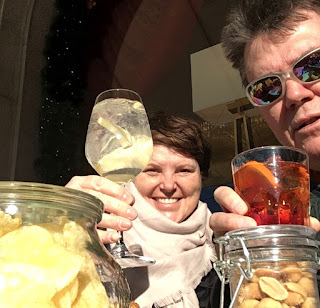On Wednesday morning we made the trip to Miramare.
Our last afternoon and evening in Trieste (Wednesday) offered a final opportunity to stroll aimlessly, ingest random coffees and cocktails, and seek the appropriate venue for our evening meal.
Trieste's Canal Grande (Grand Canal) is the result of an 18th-century program to reclaim salt marshes and add a system of canals as an extension of the city's harbor. The idea was to allow boats to load and unload at canal-side warehouses and businesses. In the end, the Grand Canal was the only one built.
Meanwhile, the "Liberty" architectural style is Italy's variation on Art Nouveau.
In the Art Nouveau era, Trieste was part of Austria-Hungary. It was the fourth biggest city of the empire and also its major seaport. Art Nouveau was very popular in Trieste, like in Vienna, Budapest, and Prague, but the buildings in that style look clearly more Italian here. This can be verified if one takes a look at the names of the architects of the buildings below.
We passed this Liberty building twice before I thought to take a photo.
Casa Terni / Casa Smolars
Via Dante Alighieri 6
Romeo Depaoli, 1906
This is probably the most outstanding Liberty building in Trieste. It consists of three parts. The central part stands a bit behind the lateral wings. The façade shows superabundant plastic richness and has a chiaroschuro effect with the big variation of its horizontals and verticals and receding and protruding elements. In the design of the ground floor, the architect was inspired by the works of Max Fabiani. There are sophisticated angular balconies at the corners. Another striking element is the round window flanked by two female sculptures above the main entrance (made by Romeo Rathmann).
Constructed for Augusto Terni, the building was later called Casa Smolars, because of the a stationery shop owned by Costanza Carniel Smolars located at the corner of Via Giuseppe Mazzini and Via Dante Alighieri.
Saint Spyridon Church opened in 1868. It is tangible evidence of the Triestine melting pot.
The Orthodox community in Trieste was established in 1748 but it wasn't until 1751 when Empress Maria Theresa allowed free practice of religion for Orthodox Christians, this prompted immigration of Serbian traders from Herceg Novi, Trebinje and Sarajevo to Trieste.
Another Liberty style building bears separatist sentiments on the Piazza della Borsa.
Casa Bartoli
Piazza della Borsa 7
Max Fabiani, 1905-1906
This is one of the most famous Liberty-style buildings in Trieste. Here as well as in his other buildings in Trieste, Fabiani followed the rational style of his master Otto Wagner. The Liberty style is visible on the upper two floors where there is a beautiful leaf cascade ornamentation, whereas rationality is expressed in the organisation of the building. The lower part, dedicated to business, has space arrangement and large windows characteristic of department stores. On the storey with the veranda operated Restaurant Goldberger, a kosher café-restaurant for observant Jews. The floral ornamentation of the upper floors is said to have been imposed on Fabiani to beautify the building which, otherwise, would have looked too avant-garde. Fabiani had originally only designed the grating that adorns the floors below. There are elegant balconies in front of the windows.
This walk brought us back to Piazza Unità d'Italia. Sensible budget travel practice recommends against patronizing sidewalk cafes on the main square, but on a day like this with a view like this, who cares? I was thirsty for Negroni, Diana for gin and tonic, and while the Caffè degli Specchi may be on the pricey side, each drink came with a small meal of peanuts and snacks.
And their sweets ...
... incredible.
Caffè degli Specchi has always been considered Trieste's front parlour. Traders, intellectuals, army officers, all met here, also because it was the venue of concerts directed by the young Franz Lehar.
This brings us to a near-comical effort to find a restaurant open (a) reasonably early after the standard afternoon break, which usually is a challenge in places like Italy, and (b) having found one with posted hours indicating it was open, for it actually to be ready for service.
Our objective was a buffet (or bufet), which in Trieste means a cross between a delicatessen and a full-service restaurant specializing in pork dishes and fare more Central European than what we consider Italian (actually Neapolitan and Sicilian).
After striking out twice at joints that were supposed to be operational but weren't, I was in the middle of a rant, saw a big German beer sign, and was introduced to the Buffet Rudy Spaten.
While the remnants of Trieste's Austro-Hungarian heritage can be seen throughout the city, Rudy's is the quintessential haven of Bavaria culture, cuisine and of course beer - all straight from Munich to your table a few steps from the Mediterranean. A bit dark and cramped as any good beer hall should be, Rudy's serves up a mouthwatering array of soups, dumplings, boiled meats, Bavarian specialities, and even a few Italian and Slovene dishes. Our favourite dishes include the Octoberfest Plate (with three kinds of wurst) and the tender sliced beef with rocket and Grana Padano cheese. Ordering a draught beer is not required, but should be.
Granted, the primary motif at Rudy is Bavarian, and fresh dark lager from Spaten a wonderful bonus, but we ordered dishes more typical of Trieste.
Local ham with
Jota, or Trieste's native bean, sauerkraut and pork stew.
Ljubljana/Slovene-style schnitzel, pounded pork stuffed with ham and cheese.
Beef goulash on a plate.
The meal was brilliant, and a fitting conclusion to our stay in Trieste, a city that isn't letting go of me. As a review: 18 THINGS TO KNOW BEFORE YOU GO TO TRIESTE.
Or after you go.
Next, the 36-hour saga from Trieste to Zagreb to Munich to Charlotte to Louisville, and finally home.



































No comments:
Post a Comment